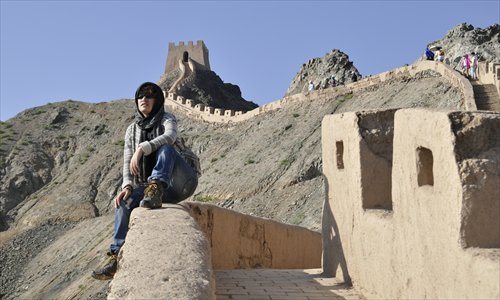

Lü Chengfeng at the Great Wall portion of the Silk Road. Photo: Courtesy of Lü Chengfeng
She said she was also especially captivated by the Danxia landforms, a palisade of pastel colored ridges and cliffs.
"It's the extraordinary, astonishing work of the nature. It reminded me that nature, not human beings, is the greatest creator of all."
Westwards beyond China
Unlike Tian and Wang, who have only visited sites along the domestic sections of the Silk Road, Lü Chengfeng, 31, has traveled the entire route from Xi'an to Rome three times in the past four years.
"One should travel along the Silk Road at least once in his or her life," said Lü, who works for the Chinese-language Driving Tour magazine. "Each time I've been on the Silk Road, I've discovered something new about it, as well as discovered something new about myself."
Lü said that journeying along the Silk Road was not only about history and culture, but also about the obstacles faced that would test one's physical endurance and force one to learn more about themselves. "Standing in front of the historical sites, which have fallen into disrepair and are basically unknown to locals, I felt so emotional," he said.
Lü suggested for people who wanted to complete the domestic Silk Road route, they can follow the journey charted by Han Dynasty envoys and merchants, which takes the traveler through Xi'an in Shaanxi Province, Lanzhou, Dunhuang and Zhangye in Gansu Province, Urumqi and Kashgar in Xinjiang Uyghur Autonomous Region. Along this route, tourists will pass the imperial tombs, the Maijishan grottoes, the Mogao grottoes, the Crescent Spring, the Yumenguan (Jade Gate Pass) and several ancient temples and towns.
According to Lü, it takes about 15 days to travel the China portion of the Silk Road by driving, and 50 days to finish the whole route, which takes the tourists through Kazakhstan, Turkey and Russia. He warned novice travelers to expect an arduous journey.
"It's a trip for people who are interested in history and culture," said Lü. "Regular travelers with petit bourgeoisie values who only want to see the ocean will most likely be bored."
The future of the Silk Road
One of the challenges that remain for travelers interested in journeying along the Silk Road is the lack of infrastructure to support large scale tourism.
Dai Bin, head of the China Tourism Academy, said at the China International Travel Mart in Shanghai last month that the lack of transportation, accommodation and dining facilities along the Silk Road meant that most tourists had to resort to relying on tour groups. Many of the areas along the Silk Road are currently sparsely populated, the People's Daily reported.
"This is the major difficulty that we're facing in terms of the future development of tourism along the Silk Road," Dai said. He said that the key for the provinces along the route to attract more tourists is to further develop public infrastructure, since self-guided tours are gradually usurping group tours as the preferred way to travel in China.
During her trip, Tian noticed that the lack of infrastructure meant that visiting tourist sites was often chaotic, potentially risking the integrity of the historical sites.
"We saw people secretly taking photos of the Mogao grottoes, which is against the rules, and stepping out onto the Danxia landform," said Tian. "But the guards were not efficient or persuasive enough to stop them."
Lü also noted that the difficulty of acquiring visas have also prevented tourists from following the Silk Road outside of China.
There are signs however, that such problems are being addressed. In June, a passenger route by train along the Silk Road was opened, carrying travelers from Xi'an to Urumqi, the capital of Xinjiang. It came in the wake of the first international cargo route by train along the historic Silk Road last year, which transported goods between Alma Ata, Kazakhstan and Xi'an, according to a Xinhua news report.
Development is expected to continue. Last September, President Xi Jinping proposed during an official visit to Kazakhstan that a new "economic belt" be built along the Silk Road, to forge closer economic ties between countries situated on the historical route through joint development of infrastructure and the implementation of policies that will invigorate trade and investment, Xinhua reported.
Copyright ©1999-2018
Chinanews.com. All rights reserved.
Reproduction in whole or in part without permission is prohibited.